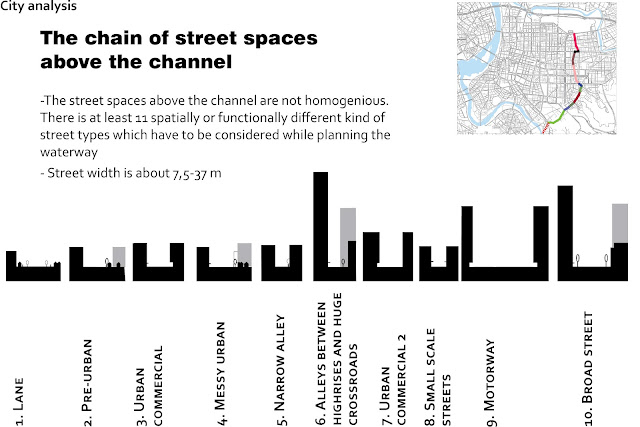-some issues and some solutions
Water Quality of the Leo Kong Channel
One of the
main problems with opening up the Leo Kong channel is that the water flowing
through the rivers of Taipei is polluted. The channel starts form the orange X
in the picture below and the channel is marked blue. The light blue markers
show four bridges that are measuring points for the Environmental Protection
Administration in Taiwan.
The water
quality values for the four sites on the map can be found in the tables below
including the water quality standards set by Environmental Protection
Administration.
The orange
cells of the table above shows which values exceed the water quality standards
for class A waters, which means that suspended solids, biochemical oxygen
demand, nutrients (nitrogen and phosphorus) and bacteria need to be reduced for
the water to be advisable for people to swim in. Some of the values measured
are not even sufficient for public water before sufficient cleaning by
Taiwanese standards. If the water is not treated, it can still be used for raising
trout, sweetfish, perch, carp, grass carp and mollusks. The lower quality water
is also allowed in manufacturing and as cooling water.
The next
table below shows the values for metals in the water and the standards for
protection of human health. The levels are all below the limit for human health,
which means that the water can be used for agriculture in terms of toxicology.
The Kaoping River Rail Bridge Constructed Wetland
A similar
project has been done in Kaoshiung City, the second biggest city in Taiwan. The wetland was commisioned in 2004.
The
wetland has two systems, one with incoming water from a paper mill and the
other from local drainage systems containing untreated domestic, agricultural, and
industrial wastewaters. Below is an
overview of the constructed wetland, and the lower system (B1-7) is the one
that is interesting for the Leo Kong channel project. The system consists of a
series of meandering bits of river and ponds for nutrient and suspended solids
retention. The red and blue arrows indicate flow directions within the systems.

This table
shows some water quality values for the wetland, system B is marked. These data
can give an indication of what would happen with the Leo Kong channel values
after a similar treatment. The values show that the wetland works very well for
reducing coliform bacteria and phosphorus when considering the efficiency
expressed in percent. This means that there is hope for treating the Leo Kong
channel water relatively successfully. The water in the Kaoping wetland however, does not meet the stringent water reuse standrads, even if the water quality is significantly improved.
Design of a Constructed
Wetland
One very
important part of nutrient retention as well as treatment of bacteria is the
flora that is put into the system. These are some examples of plant species
that are commonly used in constructed wetlands.
For the Leo Kong channel however,
we are mainly interested in native plants to Taiwan to enhance and support the
native flora and fauna and to prevent introduction of species that can be
dangerous to the existing ecosystem.
There are several ways of
integrating plants in wetlands, ponds, rivers and streams. Here are a couple of
examples of how plants can be integrated in innovative ways.
Other
techniques involve collection of sediment in the water, like a sub surface
sediment trap shown below. It can be designed so that all water has to pass
through it or so that some of the water is still allowed to pass over the top
and into a waterfall.
Waterfalls
are not just pretty, but they also help aeration of the water, which increases
the amount of dissolved oxygen in the water.
The sketch below shows two
versions of a weir. This system helps for flood control and stream regulation. The
weir can be designed after preference, for example so that is always lets
through a certain amount of water at low flows but a higher amount at larger
flows or the other way around.
A good way
of improving the habitat of fish and other fauna is to place boulders in the
bottom of a stream for example in a bend, which breaks up the flow of the
stream. A cluster of boulders or small islands can also be beneficial in a pond
or a wetland.
The Leo
Kong channel will pass through some more populated areas with shops etc, where
the streets must get enough space and where the river should still be visible.
Designs similar to the ones below allow contact and closeness to the water
without compromising safety. With foil underneath the channel, the water cannot
go anywhere but downstream and concrete and other materials suitable to the
area can assure that there will be no erosion so that the streets and the
traffic is protected.











